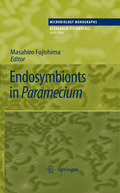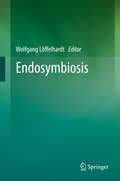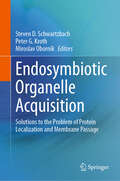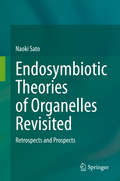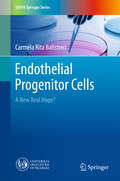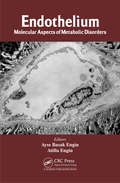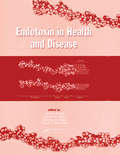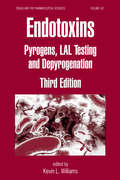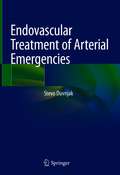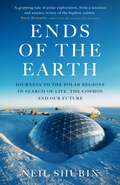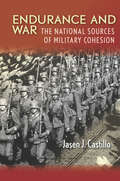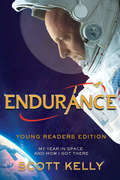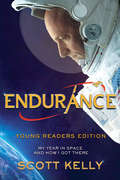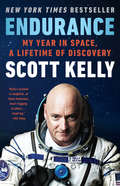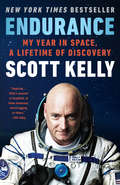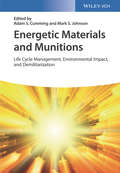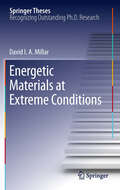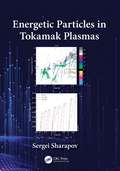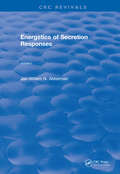- Table View
- List View
Endosymbionts in Paramecium
by Masahiro FujishimaEndosymbiosis is a primary force in eukaryotic cell evolution. In order to understand the molecular mechanisms involved in this mutualistic relationship, experiments to reproduce endosymbiosis are indispensable. The ciliate "Paramecium" is an ideal host for performing such studies. Topics presented in this volume are: the origins of algal and bacterial symbionts in "Paramecium", the diversity of endosymbiotic bacteria, such as "Holospora" bacteria and especially "Chlorella" species, as well as the infection and maintenance processes. The metabolic control, the regulation of circadian rhythms and photobiological aspects of the mutualistic association, as well as the killer effect of "Paramecium" and its causative agents are further points discussed.
Endosymbiosis
by Wolfgang LöffelhardtThe origin of energy-conserving organelles, the mitochondria of all aerobic eukaryotes and the plastids of plants and algae, is commonly thought to be the result of endosymbiosis, where a primitive eukaryote engulfed a respiring α-proteobacterium or a phototrophic cyanobacterium, respectively. While present-day heterotrophic protists can serve as a model for the host in plastid endosymbiosis, the situation is more difficult with regard to (the preceding) mitochondrial origin: Two chapters describe these processes and theories and inherent controversies. However, the emphasis is placed on the evolution of phototrophic eukaryotes: Here, intermediate stages can be studied and the enormous diversity of algal species can be explained by multiple secondary and tertiary (eukaryote-eukaryote) endosymbioses superimposed to the single primary endosymbiotic event. Steps crucial for the establishment of a stable, mutualistic relationship between host and endosymbiont, as metabolic symbiosis, recruitment of suitable metabolite transporters, massive gene transfer to the nucleus, development of specific translocases for the re-import of endosymbiont proteins, etc. are discussed in individual chapters. Experts, dealing with biochemical, genetic and bioinformatic approaches provide insight into the state of the art of one of the central themes of biology. The book is written for graduate students, postdocs and scientists working in evolutionary biology, phycology, and phylogenetics.
Endosymbiotic Organelle Acquisition: Solutions to the Problem of Protein Localization and Membrane Passage
by Steven D. Schwartzbach Peter G. Kroth Miroslav OborníkThis volume provides in depth reviews of the protein targeting translocation processes, gene transfer processes and genome reduction processes in the host and in the endosymbiont which were likely utilized during the evolution of an endosymbiont into mitochondria, mitochondria related organelles, simple and complex chloroplasts. These reviews cover both the current understanding of the host processes as well as the evolutionary outcomes used by these organelles for protein targeting and translocation. Reviews of the current knowledge of these topics are plentiful but scattered throughout the bacterial, parasite, plant and animal literature; here, reviews of current knowledge with evolutionary outcomes and future perspectives, written by leading researchers in their respective areas, are united into one comprehensive volume, essential for students and scientists interested in or working onsubcellular protein localization, protein targeting signals, translocation of proteins across and insertion into membranes, nucleic acid transfer between genomes, genome reduction and evolution of mitochondria and chloroplast.
Endosymbiotic Theories of Organelles Revisited: Retrospects and Prospects
by Naoki SatoThis book re-examines the endosymbiotic theory, and presents various related theories and hypotheses since the first proposal in 1905 by a Russian biologist. It also demonstrates that Lynn Margulis’s contribution to the current endosymbiotic is less than sometimes thought, and presents a plausible idea on how the organelles were formed. Explaining that Margulis’s initial work did not intend to show the endosymbiotic origin of chloroplasts and mitochondria, the book discusses their endosymbiotic origin in the light of current biology with the help of clear visual images. Further, by including numerous historical facts and details of phylogenetic analyses using recent genomic data that are largely unknown to many in the field, it offers deep insights into the history of biology, phylogenetic analysis, and the new evolutionary thinking. 2017 was the 50-year anniversary of Margulis’s first paper in the Journal of Theoretical Biology, and 2020 will mark 50 years since the publication her famous work Origin of Eukaryotic Cells, and as such this book offers a timely reconsideration ofthe works of Lynn Margulis and the endosymbiotic origin of organelles.
Endothelial Progenitor Cells
by Carmela Rita BalistreriThis book explores the role of endothelial progenitor cells (EPCs) in the context of regenerative medicine (RegMed). In particular, it reveals the value of RegMed as a new TM branch intended to improve the health and quality of life, by restoring, maintaining or enhancing tissue and functions of organs. The book is divided into three chapters, the first of which describes the relevance of translational medicine (TM) as a new research approach to counteract the imposing challengeof age-related diseases. Of the diverse RegMed approaches, particular attention is paid to stem/progenitor cell-based therapies, their benefits and shortcomings, as well as to the description of types of stem and progenitor cells considered for regenerative cell therapies, such as EPCs as emerging candidates for RegMed applications. In turn, the second chapter outlines the clinical relevance of EPCs as both potential predictors, diagnostic and prognostic biomarkers of age-related diseases and therapeutic agents,discussing their advantages, disadvantages, and conflicting data. Chapter three proposes a potential roadmap for revising the findings and creating a clearer picture of valid data, which can provide support for various important aspects, i. e. isolating and characterizing EPCs by establishing standardized criteria for EPC research, identifying appropriate sub-populations for cell therapy, timing, dosing, priming of cells,and defining delivery modes for different applications. The book concludes with an overview of innovative strategies that could improve the efficacy of cell therapy at all levels, including cell priming, bio-nanotechnology, and tissue engineering.
Endothelial Signaling in Development and Disease
by Mirko Hh Schmidt Stefan LiebnerThis book surveys healthy and diseased vascular systems in a multitude of model organisms and systems. It explores a plethora of functions, characteristics, and pathologies of the vascular system such as angiogenesis, fibroblast growth factor signaling, lymphangiogenesis, junctional signaling, the extracellular matrix, vascular permeability, leukocyte extravasation, axon guidance factors, the angiopoietin system, and chronic obstructive lung disease. Following a preface from leading researcher Dr. Holger Gerhardt, the text is divided into three sections- the first examining the development of the vascular system in a variety of contexts, the second delving into its homeostatic characteristics, and the third discussing its pathophysiologies. The sixteen chapters, which represent international clinical and research perspectives, highlight the importance of molecular and signaling pathways for translational basic science and clinical medicine. Additionally, the text explores new and exciting fields in vascular biology research. Comprehensive in both content and approach, Vascular Signaling in Health and Disease is ideal for graduate students, researchers, and clinicians interested in vascular biology, pneumology, and molecular biology.
Endothelin Receptors: From the Gene to the Human (Handbooks in Pharmacology and Toxicology)
by Jr. RuffoloSince the discovery of endothelin, major advances have been made in understanding the molecular structure and function of the endothelin receptors. At least two subtypes of receptors, designated ETA and ETB, have been identified through biochemical and pharmacological techniques. These subtypes are cloned and expressed and additional subtypes appear to exist. The biochemical events involved in the signal transduction processes that ultimately activate the cellular machinery involved in the end-organ responses are presented, as are the mechanisms by which the receptors recognize specific and different G-proteins. Functions mediated by the receptors at the cellular, tissue and, organ level are reviewed in detail, as well as the roles that they may play a part in the physiologic and pathophysiologic processes in animals and in humans.This book is unique in its breadth of scope. The most recent and important advances, from the intracellular level of the nucleus to the functional effect that endothelin receptors mediate in intact organs, are compiled and reviewed.
Endothelium: Molecular Aspects of Metabolic Disorders
by Atilla Engin Ayse Basak EnginThe function and life span of endothelial cells have a large impact upon the quality and expectancy of an individual's life. During low perfusion, the adaptation of different cells to hypoxia precipitate the aggressive progression of diseases. Although the clinical studies have convincingly shown that endothelial dysfunction occurs whenever the bio
Endotoxin in Health and Disease
by Helmut Brade; Steven M. Opal; Stefanie N. Vogel; David C. MorrisonOffering a basis for further research into the interactions of hosts and pathogens, this work gathers up-to-date findings, and details basic structures, functions and immunology. It provides descriptions of a variety of experimental endotoxin neutralizing agents, as well as a guide to clinical research initiatives and the latest treatments.
Endotoxine und Pyrogene: Nachweisverfahren, Produktprüfung, Inaktivierung
by Michael RiethDiese erste deutschsprachige Übersicht beschreibt praxisnah alle verfügbaren und in der europäischen Pharmakopöe aufgenommenen Nachweisverfahren für bakterielle Endotoxine und andere Pyrogene. Jede Methode wird ausführlich beschrieben und anhand von Praxisbeispielen einschließlich der produktbezogenen Methodenvalidierung präsentiert. Neueste Erkenntnisse zur Maskierung von Endotoxinen und dem LER (low endotoxin recovery)-Effekt sowie neuentwickelte Methoden zur Endotoxinbestimmung mittels rekombinanter Testsysteme werden vorgestellt. Eine Beschreibung der notwendigen Ausrüstung sowie der hauptsächlichen Einsatzgebiete runden dieses Buch ab.
Endotoxins: Pyrogens, LAL Testing and Depyrogenation (ISSN)
by Kevin L. WilliamsThis source expertly examines the discovery, biological structure, control, and continued clarification of endotoxin from a parenteral manufacturing perspective, with in-depth discussion of state-of-the-art technologies involving Limulus amebocyte lysate (LAL) such as assay development, automation, depyrogenation. Completely revised and exp
Endovascular Treatment of Arterial Emergencies
by Stevo DuvnjakThis book presents a practical overview of the widely used endovascular treatment of arterial emergencies, covering the majority of cases encountered in praxis. Including a wealth of high-quality images of arterial emergencies and treatment descriptions, it provides readers with essential information and shares insights into endovascular options. However, the book focuses on presenting common arterial emergencies from diagnosis to treatment only, without exhaustively describing all endovascular options. The clinical cases explore thoracic arterial emergencies, followed by abdominal emergencies and peripheral arterial emergencies. Rare clinical cases are also examined. The book offers interventional radiologists, vascular surgeons and cardiologists, as well as residents in these disciplines, a valuable tool for use in their everyday clinical praxis.
Ends of the Earth: Journeys to the Polar Regions in Search of Life, the Cosmos, and Our Future
by Neil ShubinThe bestselling author of Your Inner Fish takes readers on an epic adventure to the North and South Poles to reveal the secrets locked in the ice about life, the cosmos, and our planet&’s future. Renowned scientist Neil Shubin has made extraordinary discoveries by leading scientific expeditions to the sweeping ice landscapes of the Arctic and Antarctic. He&’s survived polar storms, traveled in temperatures that can freeze flesh in seconds, and worked hundreds of miles from the nearest humans, all to deepen our understanding of our world. Written with infectious enthusiasm and irresistible curiosity, Ends of the Earth blends travel writing, science, and history in a book brimming with surprising and wonderful discoveries. Shubin retraces his steps on a &“dinosaur dance floor,&” showing us where these beasts had populated the once tropical lands at the poles. He takes readers meteor hunting, as meteorites preserved in the ice can be older than our planet and can tell us about our galaxy&’s formation. Readers also encounter insects and fish that develop their own anti-freeze, and aquatic life in ancient lakes hidden miles under the ice that haven&’t seen the surface in centuries. It turns out that explorers and scientists have found these extreme environments as prime ground for making scientific breakthroughs across a vast range of knowledge. Shubin shares unforgettable moments from centuries of expeditions to reveal just how far scientists will go to understand polar regions. In the end, what happens at the poles does not stay in the poles—the ends of the earth offer profound stories that will forever change our view of life and the entire planet.
Ends of the Earth: Journeys to the Polar Regions in Search of Life, the Cosmos, and our Future
by Neil ShubinFrigid, remote and inhospitable – the polar regions seem far removed from our everyday lives. But these seemingly isolated ice realms shape life on our planet far more than we realise, influencing everything from the climate to ocean health. They may even hold the secrets to the origins of the Earth. Taking an epic journey of discovery from pole-to-pole, ferrying between penguins and polar bears, Ends of the Earth reveals the polar regions as never before. Meeting with the leading physicists, climatologists, geologists, biologists and palaeontologists working in these extremes – often as eccentric as they are intrepid – Neil Shubin presents the compelling new science of the Arctic and Antarctic with characteristic verve and expertise.
Endurance and War: The National Sources of Military Cohesion
by Jasen J. CastilloScholars and military practitioners alike have long sought to understand why some country's militaries fight hard when facing defeat while others collapse. In Endurance and War, Jasen Castillo presents a new unifying theory—cohesion theory—to explain why national militaries differ in their staying power. His argument builds on insights from the literatures on group solidarity in general and military effectiveness in particular, which argue that the stronger the ties binding together individuals in a group of any kind, the higher the degree of cohesion that a group will exhibit when taking collective action, including fighting in war. Specifically, he argues that two types of ties determine the cohesion, and therefore the resilience, of a nation's armed forces during war: the degree of control a regime holds over its citizens and the amount of autonomy the armed forces possess to focus on training for warfighting. Understanding why armed forces differ in their cohesion should help U.S. military planners better assess the military capabilities of potential adversaries, like Iran and North Korea. For scholars of international politics, cohesion theory can help provide insights into how countries create military power and how they win wars.
Endurance, Young Readers Edition: My Year In Space And How I Got There
by Scott KellyAn awe-inspiring memoir from NASA astronaut Scott Kelly who spent a record-breaking year in space, now newly adapted for young readers.Prepare to blast off with astronaut Scott Kelly as he takes readers on a journey through his year aboard the International Space Station and his life prior to becoming a true American hero.Discover the extreme challenges of long-term spaceflight, the pressures of living in close quarters with people from many countries, the extremely dangerous risk of colliding with space junk and the unnerving feeling of not being able to help if tragedy strikes at home. Find out the story of Kelly's childhood, his struggles in school, and ultimately the inspiration that sparked his incredible career, and the training to become a test-pilot and then astronaut.This personal and fascinating story will encourage aspiring astronauts and young readers everywhere to believe in the impossible and reach for the stars.
Endurance, Young Readers Edition: My Year in Space and How I Got There
by Scott KellyNewly adapted for young readers from the New York Times bestseller comes the awe-inspiring memoir from NASA astronaut Scott Kelly, who spent a record-breaking year in space.How does a boy struggling in school become an American hero and a space pioneer?Daredevil behavior? Check. Whether it is sailing leaky boats in the Atlantic Ocean or joining an ambulance corps to race to the rescue, living on the edge is required behavior for an astronaut.Sibling rivalry? Check. An identical twin brother who both cheers you on and eggs you on is the perfect motivator. Inspiration? Check. Finding the right book can unexpectedly change the course of your life by providing a dream and a road map for achieving it. Courage? Check. Mastering skills that could mean the difference between life and death as a fighter pilot, test pilot, and astronaut takes bravery.Endurance? Check. The grit and can-do spirit that enables you to get up every time you're knocked down and fuels the power to meet each challenge head-on and then ask, "What's next?"Scott Kelly believes, "If you can dream it, you can do it." This checklist put Scott on a rocket that launched him into space, allowed him to break a record during his inspiring year aboard the International Space Station, and showed human beings the qualities needed to go from Earth to Mars--and beyond."An engaging and high-flying read for nonfiction and space lovers alike." --School Library Journal"Those who are intrigued by space travel will find this a fascinating book." --Booklist
Endurance: A Year in Space, A Lifetime of Discovery
by Scott Kelly<P>A stunning, personal memoir from the astronaut and modern-day hero who spent a record-breaking year aboard the International Space Station—a candid account of his remarkable voyage, of the journeys that preceded it, and of his colorful and inspirational formative years. <P>The veteran of four spaceflights and the American record holder for consecutive days spent in space, Scott Kelly has experienced things very few have. Now, he takes us inside a sphere utterly hostile to human life. He describes navigating the extreme challenge of long-term spaceflight, both life-threatening and mundane: the devastating effects on the body; the isolation from everyone he loves and the comforts of Earth; the catastrophic risks of colliding with space junk; and the still more haunting threat of being unable to help should tragedy strike at home--an agonizing situation Kelly faced when, on a previous mission, his twin brother's wife, American Congresswoman Gabrielle Giffords, was shot while he still had two months in space. <P>Kelly's humanity, compassion, humor, and determination resonate throughout, as he recalls his rough-and-tumble New Jersey childhood and the youthful inspiration that sparked his astounding career, and as he makes clear his belief that Mars will be the next, ultimately challenging, step in spaceflight. <P>A natural storyteller, Kelly has a message of hope for the future that will inspire for generations to come. Here we see the triumph of the human imagination, the strength of the human will, and the infinite wonder of the galaxy. <P><b>A New York Times Bestseller</b>
Endurance: A Year in Space, a Lifetime of Discovery
by Scott Kelly<P>A stunning, personal memoir from the astronaut and modern-day hero who spent a record-breaking year aboard the International Space Station—a candid account of his remarkable voyage, of the journeys that preceded it, and of his colorful and inspirational formative years. <P>The veteran of four spaceflights and the American record holder for consecutive days spent in space, Scott Kelly has experienced things very few have. Now, he takes us inside a sphere utterly hostile to human life. He describes navigating the extreme challenge of long-term spaceflight, both life-threatening and mundane: the devastating effects on the body; the isolation from everyone he loves and the comforts of Earth; the catastrophic risks of colliding with space junk; and the still more haunting threat of being unable to help should tragedy strike at home--an agonizing situation Kelly faced when, on a previous mission, his twin brother's wife, American Congresswoman Gabrielle Giffords, was shot while he still had two months in space. <P>Kelly's humanity, compassion, humor, and determination resonate throughout, as he recalls his rough-and-tumble New Jersey childhood and the youthful inspiration that sparked his astounding career, and as he makes clear his belief that Mars will be the next, ultimately challenging, step in spaceflight. <P>A natural storyteller, Kelly has a message of hope for the future that will inspire for generations to come. Here we see the triumph of the human imagination, the strength of the human will, and the infinite wonder of the galaxy. <P><b>A New York Times Bestseller</b>
Energetic Materials and Munitions: Life Cycle Management, Environmental Impact, and Demilitarization
by Adam Stewart Cumming Mark S. JohnsonProvides a hands-on approach to demilitarization and environmental aspects of energetic materials and munitions This book gives an overview of the environmental impact of the production, use, and cleanup of energetic materials and munitions. It provides scientists, engineers, environmental specialists, and users with the understanding of environmental issues for munitions and of the ways to improve design and manage potential risks. It covers the various aspects of how chemical properties influence fate, transport, and toxicity of new formulations and prescribes tools for reducing or alleviating environmental risks. In addition, it discusses pyrotechnics and the problem of dealing with munitions underwater. Chapters in Energetic Materials and Munitions: Life Cycle Management, Environmental Impact and Demilitarization look at demilitarization in general, as well as in the future. Topics covered include logistics, costs, and management; life cycle analysis and management; and greener munitions. Another introduces readers to the "One Health" approach in the design of sustainable munition compounds. Following that, readers are taught about land assessment for munitions-related contamination in military live-fire training. The book also examines the development and integration of environmental, safety, and occupational health information. -Brings together in one source expertise and in-depth information on the current and future state of how we handle the production, use, and demilitarization of explosives and weaponry -A handy reference for experienced practitioners, as well as for training young professionals in the field -Every chapter contains real-life examples and proposes future directions for the field Energetic Materials and Munitions: Life Cycle Management, Environmental Impact and Demilitarization is an important book for explosives specialists, pyrotechnicians, materials scientists, military authorities, safety officers, health officers, and chemical engineers.
Energetic Materials at Extreme Conditions
by David I.A. MillarDavid I.A. Millar's thesis explores the effects of extreme conditions on energetic materials. His study identifies and structurally characterises new polymorphs obtained at high pressures and/or temperatures. The performance of energetic materials (pyrotechnics, propellants and explosives) can depend on a number of factors including sensitivity to detonation, detonation velocity, and chemical and thermal stability. Polymorphism and solid-state phase transitions may therefore have significant consequences for the performance and safety of energetic materials. In order to model the behaviour of these important materials effectively under operational conditions it is essential to obtain detailed structural information at a range of temperatures and pressures.
Energetic Particles in Tokamak Plasmas
by Sergei SharapovThe study of energetic particles in magnetic fusion plasmas is key to the development of next-generation "burning" plasma fusion experiments, such as the International Thermonuclear Experimental Reactor (ITER) and the Demonstration Power Station (DEMO). This book provides a comprehensive introduction and analysis of the experimental data on how fast ions behave in fusion-grade plasmas, featuring the latest ground-breaking results from world-leading machines such as the Joint European Torus (JET) and the Mega Ampere Spherical Tokamak (MAST). It also details Alfvenic instabilities, driven by energetic ions, which can cause enhanced transport of energetic ions. MHD spectroscopy of plasma via observed Alfvenic waves called "Alfvén spectroscopy" is introduced and several applications are presented. This book will be of interest to graduate students, researchers, and academics studying fusion plasma physics. Features: Provides a comprehensive overview of the field in one cohesive text, with the main physics phenomena explained qualitatively first. Authored by an authority in the field, who draws on his extensive experience of working with energetic particles in tokamak plasmas. Is suitable for extrapolating energetic particle phenomena in fusion to other plasma types, such as solar and space plasmas.
Energetic Particles in the Heliosphere
by George M. SimnettThis monograph traces the development of our understanding of how and where energetic particles are accelerated in the heliosphere and how they may reach the Earth. Detailed data sets are presented which address these topics. The bulk of the observations are from spacecraft in or near the ecliptic plane. It is timely to present this subject now that Voyager-1 has entered the true interstellar medium. Since it seems unlikely that there will be a follow-on to the Voyager programme any time soon, the data we already have regarding the outer heliosphere are not going to be enhanced for at least 40 years.
Energetics of Secretion Responses: Volume I (CRC Press Revivals)
by J.W.N. AkkermanProvides a multidisciplinary approach to the study of energetics of secretion responses by combining the knowledge and expertise of leading authorities from various fields.
